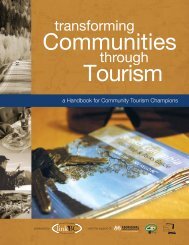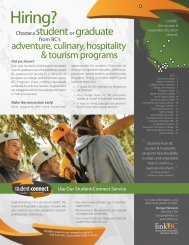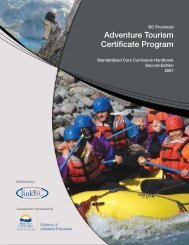Cultural Heritage Tourism Handbook - LinkBC
Cultural Heritage Tourism Handbook - LinkBC
Cultural Heritage Tourism Handbook - LinkBC
- No tags were found...
Create successful ePaper yourself
Turn your PDF publications into a flip-book with our unique Google optimized e-Paper software.
8.2 Tell Your Story Well<strong>Cultural</strong>/heritage tourism is about sharing stories. To do this, you need to build an interpretivecapability in your community. Interpretation is a complex field of knowledge, and frequently it’sthe determining factor in whether or not a tourism experience is successfully realized.Engaging ExhibitsEffective exhibits will bring your community’s cultural character to life, and should be encouraged in multiple locations. Whether professionallymounted exhibits in the local museum, or a heritage showcase developed for a hotel lobby or lounge, some useful guidelinesapply. The following has been adapted from <strong>Cultural</strong> <strong>Heritage</strong> <strong>Tourism</strong>: Practical Applications developed by the Museum Association ofArizona and the Arizona Humanities Association.The ‘father of interpretation’ in North America is Freeman Tilden, an American who helped shapeinterpretation in US national parks by drawing up this list of principles:Tilden’s Six Principles of Interpretation1. Any interpretation that does not somehow relate what isbeing displayed or described to something within the personalityor experience of the visitor will be sterile.2. Information, as such, is not interpretation. Interpretationis revelation based on information. But they are entirelydifferent things. However, all interpretation includesinformation.3. Interpretation is an art, which combines many arts, whetherthe materials presented are scientific, historical, or architectural.Any art is to some degree teachable.4. The chief aim of interpretation is not instruction, butprovocation.5. Interpretation should aim to present a whole rather thana part, and must address itself to the whole person ratherthan any part.6. Interpretation addressed to children (say, up to the ageof twelve) should not be a dilution of the presentationto adults, but should follow a fundamentally differentapproach. To be at its best, it will require a separate program.In cultural/heritage tourism, interpretation is most often associatedwith museums and heritage sites. However, all tourismbusinesses, attractions, and experiences will benefit by providinggood interpretation.Whether on signs and websites, in brochures and guidebooks, orin media promotions, the stories you tell will shape how the visitorsees and understands your community.Key Ingredients of a “Healthy” Exhibit 43£ £ The heart of the story is at risk when there are too manyelements—keep it simple.£ £ Be selective in what you display—keep the items few innumber and powerfully interpreted.£ £ Use video monitors and audio clips to maximum advantage.£ £ Be clear! Labels should be legible, clearly written in anengaging style, and not too wordy.£ £ Make the effort to add multilingual labels for your dominantvisitor groups—your guests who don’t speak English or Frenchwill appreciate this!£ £ “Exercise” your exhibits regularly—change/rotate regularly(at least twice a year), and make repairs immediately.£ £ Make sure the story you tell is authentic—keep true to thestory, relate it to the historical context, construct a contemporaryanalogy, and put a human face on it.£ £ Connect your exhibit story to your community-based cultural/heritage tourism strategy.£ £ While designing your exhibits, make parts of them portableenough to travel—an exhibit that you place in a shoppingmall, town square, or other community center might bringvisitors to your attraction that otherwise would not come.£ £ Finally, remember that your front-line team can be the bestexhibit—train your staff, both professional and volunteers, sothat everyone is familiar with the same story; can interpretthe exhibits, and are well-versed in the mission, story, and thecommunity they represent.If you choose exhibitry as one means to tell your community’sstory (and each attraction should), remember that today’s cultural/heritage tourist comes with higher expectations of quality thanever before. Exposure to sophisticated graphics in print and onlinemeans today’s visitors expect that level of polished presentationwherever they travel.When in doubt, use a professional or invite a specialist to review yourexhibit plans. If as a small business you cannot afford a designer,discounted or non-fee services may be available through a college/university museum studies or design-arts program, or with a localarts group.This next case study demonstrates how driving routes, signage,interpretation and new technology (such as QR codes) can be usedto showcase the best a community has to offer.58 59










